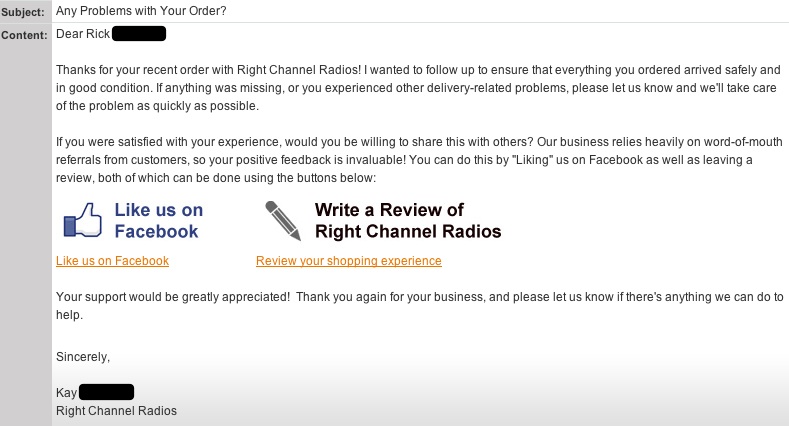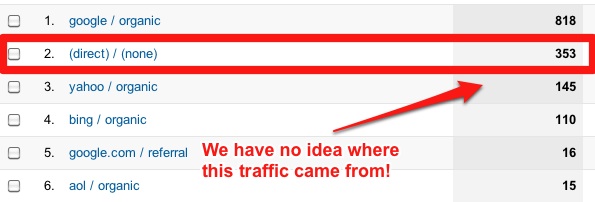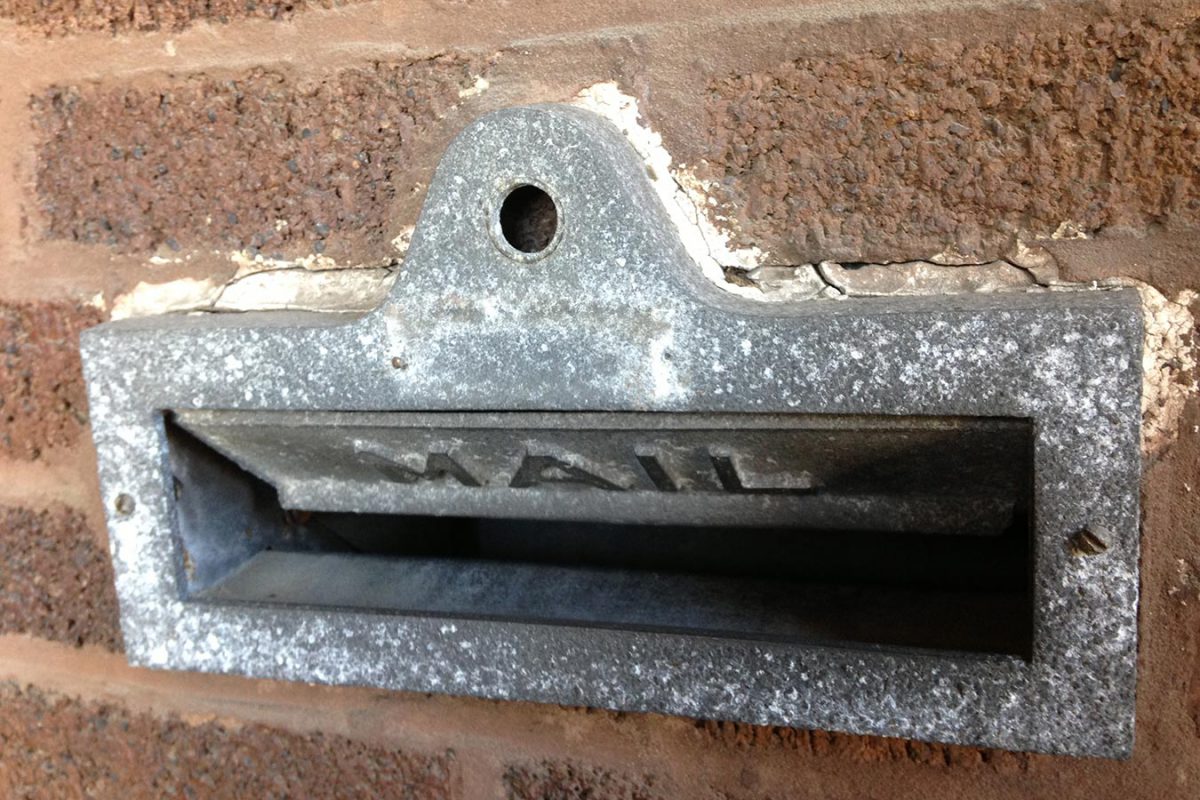
In this post I’m going to give you a sneak peek at the email marketing plan we’ll be implementing at one of my own stores, Right Channel Radios, using the email service Klaviyo. I’ll also be sharing the results of the campaign quarterly on the blog so you can see how this all pans out.
There’s nothing quite like public accountability to spur action and progress!
Emails We Currently Send
While I haven’t leveraged email to its full potential, we didn’t completely neglect our email efforts. Here are the email templates currently in place that are automatically sent to each Right Channel Radios customer after purchase:
1. Technical Resources Email
Sent the day after purchase, this email lets customers know about our radio installation and troubleshooting resources available on the website.
2. Follow-Up Email
This is one of the most important emails I think any eCommerce store can send. It’s sent about 10 days after purchase and does two things:
- Asks the customer how their order was and if there’s anything else we can do to help
- If everything was satisfactory, it asks them to “Like” us and/or leave a review
The order of these requests is important: If a customer knows you’re first and foremost concerned about their experience, they’ll be much more likely to leave you a positive review.
We only recently started asking customers to leave reviews, but have already generated 30+ reviews with a 9.1/10 satisfaction rating at TrustPilot. I especially like an excerpt from a recent comment: “To see how high their support is you would have to rent the space shuttle to see it”. Thanks, Greg!
While this follow-up email is automatically generated, we make sure someone’s real name is at the bottom and not just a generic company signature . If the customer replies to the email, it gets routed to someone at our help desk for a fast response.
You can see a sample of the email we send below:
3. Product Review Request
About 3 to 4 weeks after purchase, our customers get an email asking them to review the items they’ve purchased. The email is personalized and has links to the review page for the exact item(s) they purchased. We also appeal to our customers’ sense of community by asking them to leave a review to “help fellow radio users” to improve our response and review rate.
We’ve generated hundreds of reviews with this email, and it’s been instrumental in drastically improving our product pages with product reviews.
You can see one of the review request emails we send below:
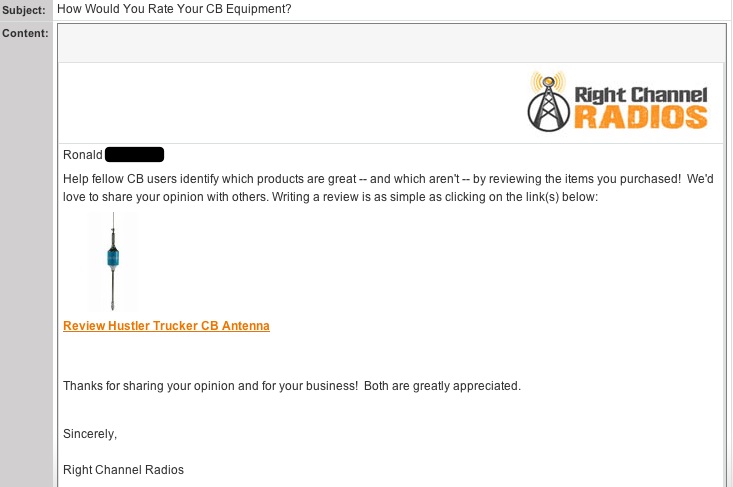
For all three of these automated emails, we use the Follow-Up Email extension from aheadWorks for Magento. It’s a little tricky to get set up – and the documentation could use some improvement – but once it’s up and running it’s great. Overall we’ve been fairly impressed with the support from aheadWorks. On one occasion, they even wrote a custom patch to solve a problem we were having for free. Impressive!
Going forward, we may switch these emails over to Klaviyo because they offer a bit more control, and we’d like to consolidate all our emails in one interface.
4. Cart Abandonment Emails
In just the last few months, we started experimenting with sending cart abandonment emails to try to recover lost sales. Any time someone partially checks out and enters their email address but doesn’t finish their purchase, we follow up with a series of emails to remind them about their cart and to encourage them to complete the purchase.
We’re still in the early stages of optimizing and testing the process, and I’ll be posting a full case study of the results in the next few months. Until then, you can get an idea for what these emails look like via the email below:
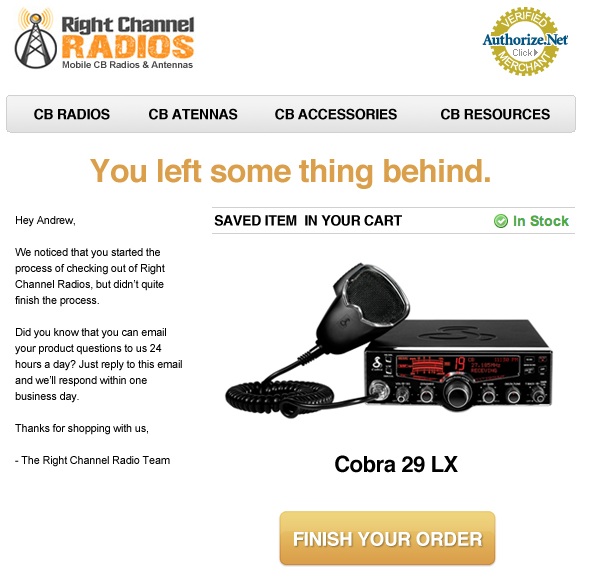
New Emails We’ll Be Adding
With the exception of the cart abandonment email, none of the previously listed messages are intended to drive revenue. Most of the new mailings we’re creating will be sent with the goal of driving repeat purchases. Here’s what we have planned:
1. General Newsletter
A regular monthly or biweekly mailing sent to all our customers. It will include heavily discounted products, new items and promotions.
2. Up-Sells for Specific Products
With Klaviyo’s product-based segmentation automation, we can automatically send a series of emails to a customer based on what they purchased. So a month after a customer purchases a radio we can automatically send them an email highlighting all of the accessories for their specific model.
I think these emails have the highest potential to drive additional sales because they’re so targeted. They also allow us to do some pretty neat service-oriented emails. For example, if someone purchases a kit, we can send them specific instructions on how to install it on their vehicle. Very cool.
3. Emails to Repeat Customers
Repeat customers are the lifeblood of any business, and we want to make sure we’re taking care of ours. We’ll be regularly sending out special promotions and incentives to all customers who have purchased from us twice or more.
4. Emails to Our Best Customers
We want to make sure we’re taking extra-special care of our most loyal customers, so we’ll be taking great care of customers who order five times or more. Deep discounts, premium service and an increased emphasis on showing appreciation are what we’ll be focusing on with this group.
5. Emails to Dormant Customers
Sending strategic emails to customers who haven’t ordered in 1-2 years is a good way to reconnect with those who may have forgotten about us. Because we’ll soon be sending regular newsletters, we also want to send a “re-introduction” email to let these customers know 1) who we are again and 2) why they’ll be hearing from us more often. We’ve recently tested one already that looks like this:
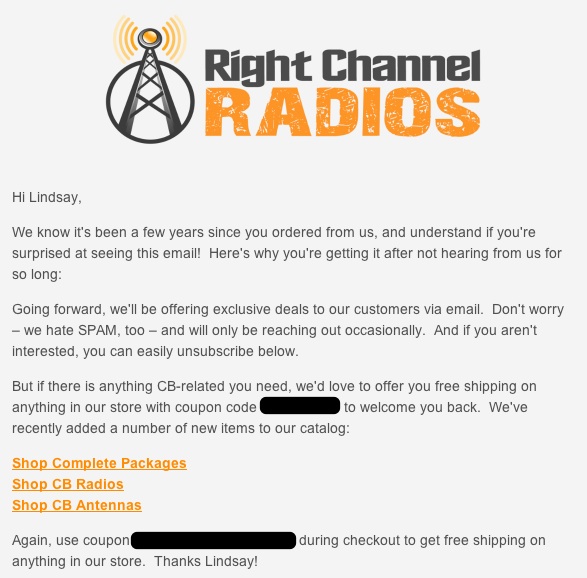
Measuring the Results
We’ll be investing a ton of time into our email campaign this year, so it’s crucial to know how our efforts are translating into revenues. But visits from links in emails appear as “Direct Traffic” in Google Analytics. This makes it impossible to separate email visits (and purchases!) from other direct traffic like people typing the site address into their browsers or visiting from a link in a PDF.
We need to be able to track our efforts and identify how much revenue is being driven by email marketing – both on an individual email basis AND from an overall email marketing campaign perspective. To do this, we’ll need to tag our links with special UTM (Urchin Tracking Module) parameters.
Using UTM Parameters
By adding some custom text to the end of a link, you can tell Google Analytics exactly where the visitor who used that link came from. Google will take that information and incorporate it into clean, organized reports in your Analytics so you can tell exactly where your traffic is coming from and which sources are most valuable.
Even if you’ve never heard of UTM parameters, you’ve almost certainly seen them online when you visit a page with a really long and complex address. For example, check out the browser address below when I clicked on an email link to read a recent ThinkTraffic.net blog post. Based on the UTM link they use, they’ll know that my visit was generated by their email feed:
A lot of people think UTM tracking is really scary and complicated, but it’s incredibly easy. You just have to append the appropriate tags to your links, and Google Analytics will automatically organize and filter your traffic.
Understanding the UTM Structure
A few rules that are important as we’ll be tagging our links:
- UTM parameters are case sensitive, so “Feed” is different than “feed”
- The UTM parameters section needs to be offset from the general URL with a “?”
- You can set up to five parameters, but three are always required: “source,” “medium” and “name”
These different parameters allow you to create a hierarchy for Google to organize your traffic. By setting them properly, we can see how our overall email marketing traffic is converting, but then also analyze how well different campaign types and even individual messages are performing. Here’s how we’ll be tagging our new emails:
The “Source” Attribute
This represents the high-level traffic source generating the traffic. For our email campaigns, we’ll be setting this to “email-marketing.” So every email that we send will include the paramater “utm_source=email-marketing.”
The “Medium” Attribute
This represents the subset generating the traffic. Assuming Google was the “source” attribute, possible medium attributes could be “organic traffic” and “pay-per-click traffic.” For our email campaign, we’ll be setting the mediums to the different high-level types of messages we outlined above. They’ll include:
- “newsletter”
- “enhancement”
- “valued-customer”
- “top-customer”
- “missed-customer”
A big “thank you” to Ric Sake who made some great recommendations to make these parameters more customer-friendly given that customers can see them in the URL field. For example, our parameter for “enhancements” use to be labeled “upsells,” but few customers want to be “upsold.” But having their experience “enhanced” is something most customers would enjoy – something that is easily changed by thinking through our labeling a bit more. You can see Ric’s entire insightful comment here. Thanks, Ric!
The “Campaign” Attribute
This identifies the exact message being sent. For our campaign, examples could include “july-newsletter” or “Uniden-Radio-Upsell.” These attributes help us tag individual messages.
This should give you a good idea about how UTM parameters work, but for more information – including lots of ideas on how to best use them – see this guide by KISS Metrics.
Creating UTM Tagged Links
You can manually create these UTM-tagged links yourself, but free URL-building tools from Google and Raven Tools make the process much easier. A tagged UTM link within our May newsletter would end up looking something like this:
https://www.rightchannelradios.com?utm_source=email-marketing&utm_medium=newsletter&utm_campaign=may-2013-newsletter
Sharing the Results
Will all this planning, tagging and segmenting actually make us any more money? You’ll get to find out! I’ll be publishing the actual results from this campaign on a quarterly basis starting in July. And I have to admit, it’s a bit nerve-racking to put a campaign publicly on the line like this … but I think it should make for some very valuable posts.
I’d LOVE to see an immediate 25% sales boost that Ed said was possible from a well-optimized mature campaign, but I’m not sure if that’s feasible within three months. While I plan to get there within the next year or two, I think a 5% to 10% boost to sales from email during the campaign’s first quarter would be a solid start.
Only time will tell, so make sure to check back in early July for the first report.
Questions? Comments? Let me Know!
Have questions about the new plan or what we’ve been doing historically with our transactional emails? Let me know in the comments below, and I’ll do my best to answer them!
Did you enjoy this post? Please share it using the buttons below!
Post photo credit.


